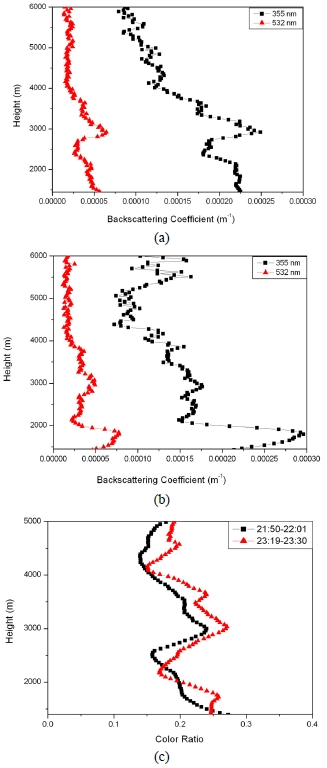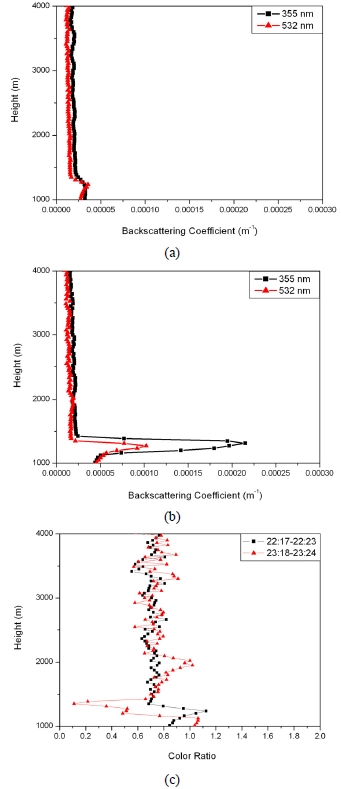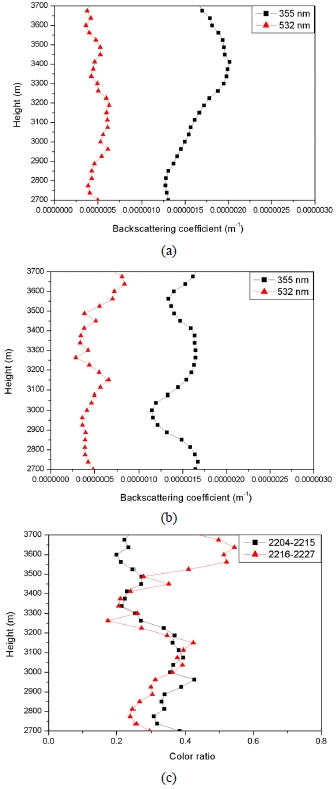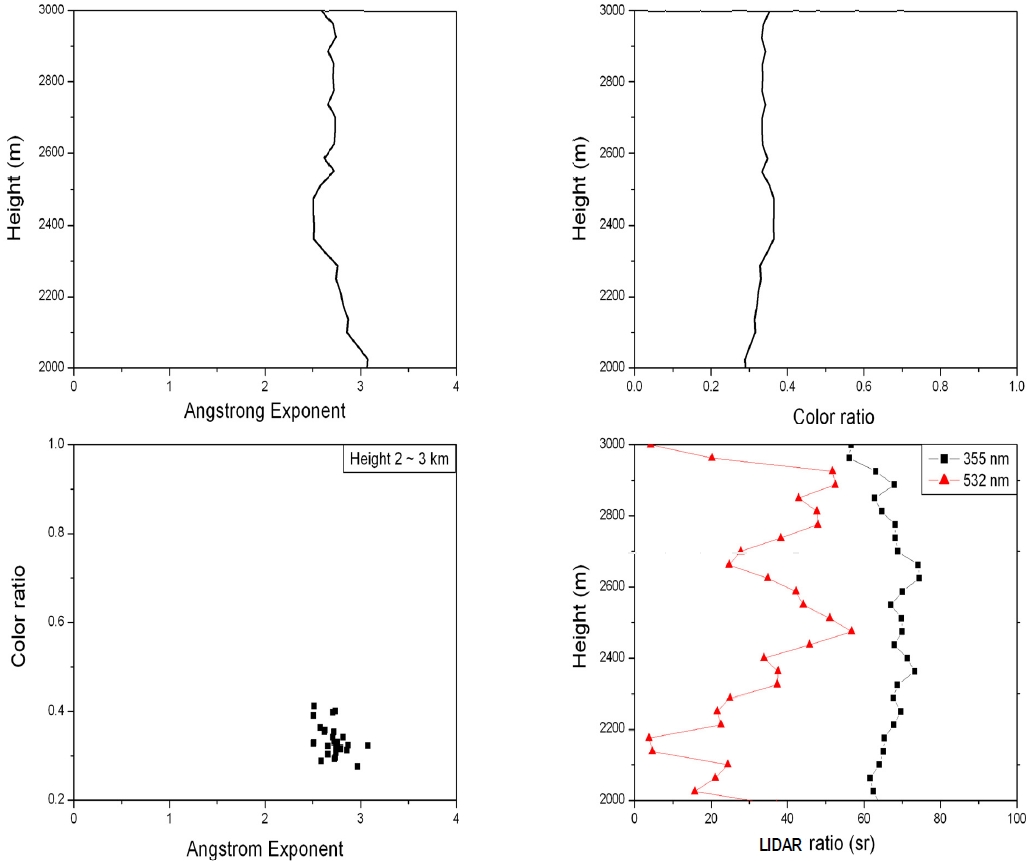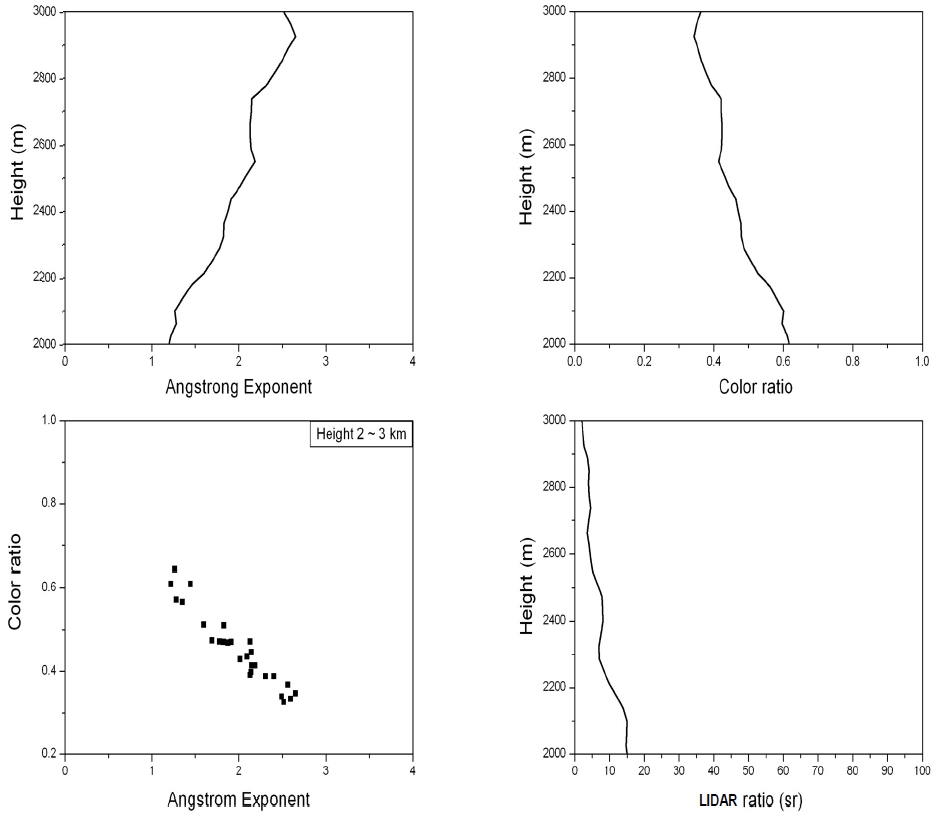


Optical properties of an atmospheric aerosol are very important parameters for predicting climate change. An aerosol has an indirect effect on the radiation budget of atmosphere providing condensation nuclei for cloud formation, because scattering and absorption of solar radiation and longwave radiation are dependent on atmospheric aerosol particle concentration, position, orientation, shape, and size. Sometimes the specific aerosol, Asian dust, impacts the Korean Peninsula or travels through the sky on the prevailing westerlies in varying degrees[1]. The occurrence rate of Asian dust has been rapidly increasing in the 2000s, and this specific Asian dust also affects the climate.
If there is fog, visibility is strongly dependent on the amount and size of water droplets. So, to predict weather changes, water droplet size change and other parameters such as temperature must be measured. Moreover, the aerosol backscattering coefficient and extinction coefficient cannot give enough information for identifying weather changes, so it is necessary to measure other parameters which are connected with aerosol size, such as Ångstrom exponent, color ratio, and LIDAR ratio[2, 3].
Many scientists have tried to measure simple aerosol properties such as backscattering coefficient, and extinction coefficient[4-6]. Moreover, they have obtained these backscattering and extinction coefficients with some assumptions such as Ångstrom exponent, color ratio, and LIDAR ratio[6, 7]. The Ångstrom exponent,
In this study, the Ångstrom exponent, color ratio, and LIDAR ratio were measured by using two wavelength rotational Raman LIDAR signals to obtain the aerosol size distribution. The backscattering coefficients, which have a close relation to atmospheric aerosol concentration were also calculated. Finally, the cloud and aerosol size characteristics were analyzed by using the Ångstrom exponent, color ratio, and LIDAR ratio.
In rotational Raman LIDAR, the two return signals can be expressed as Eqs. (1) and (2)[9, 10].
where
where
The aerosol extinction coefficient can be obtained from Eq. (1). The aerosol extinction coefficient can be expressed as Eq. (4) from Eq. (1), by substituting
From Eq. (3), the aerosol Ångstrom exponent can be obtained. As mentioned above, the two unknown values (수식삽입) in Eq. (3) can be obtained experimentally. So (수식삽입) can be calculated from the two unknown values. The ratio of backscattering coefficients, (수식삽입), at two(355 nm and 532 nm) wavelengths are given by
Since β λR =
The Ångstrom exponent
Consequently, from Eq. (6), (7), the Ångstrom exponent can be expressed as Eq.
where
III. EXPERIMENTAL SETUP AND RESULTS
In this study, the two wavelength Raman LIDAR system was installed by using a 355 nm and 532 nm laser beam of a Nd:YAG laser. The pulsed energy of the laser beams were 130 mJ and 300 mJ at 355 nm and 532 nm, respectively. Figure 1 shows a schematic diagram of the installed LIDAR system. To decrease laser beam divergence, a beam expander was used in the transmitting system, which can expand a laser beam by 10 times. The receiving system consisted of 4 channels, namely rotational Raman channels at 355 nm and 532 nm, and two elastic channels at 355 nm and 532 nm[10, 11].
Figures 2(a) and 2(b) show the change of aerosol backscattering coefficients measured using the two wavelength LIDAR signals on June 10, 2010 (cloudy day) at different times. In the figures, it can be seen that even though the boundary layer is at the same altitude (2000 m), the backscattering coefficient changes dramatically from 2.24×10-4 m-1 to 1.81×10-4 m-1 (355 nm) within the boundary layer. At the other wavelength (532 nm), the change of the backscattering coefficient with altitude is not the same as that of 355 nm. But the cause of the backscattering coefficient variance is unknown, because the backscattering coefficient is not solely dependent on the aerosol size and concentration. To obtain the quantitative information, the color ratio was calculated at two different times. Figure 2(c) shows the color ratios that have a close relation to the aerosol size distribution. In Fig. 2(c), it can be seen that the aerosol size distribution value decreased from 0.25 to 0.14 and from 0.26 to 0.15 in the boundary layer with the altitude at 21:50 and 23:19[12, 15]. In this case, the color ratios are similar to each other at all altitudes.
Figures 3(a) and 3(b) show the change of the aerosol backscattering coefficients on Dec. 4, 2007 (clear day) at different times. In Figs. 3(a) and 3(b), it can also be seen that even though the boundary layer is the same altitude (1300 m), the backscattering coefficient changes by a factor of 7 from 3.22×10-5 m-1 to 2.15×10-4 m-1 (355 nm) within the boundary layer. Figure 3(c) shows the change of the color ratio measured at these two different times. At 1000 m altitude, the color ratio value was 0.83 at 22:17, and 1.04 at 23:18, respectively. Compared with Fig. 2(c), these figures show a strong change in the color ratio within the boundary layer according to the altitude. In particular, the change of color ratio value at the boundary layer (1300 m) was dramatic even in one hour, even though the change of color ratio value within and above this boundary layer was small. It means that aerosol dynamics usually start at the surface of the boundary[13, 16]. In conclusion, the aerosol color ratio changes within the boundary layer and near the cloud, even in a short time period in this case.
Figures 4(a) and 4(b) show the change of the aerosol backscattering coefficients on May 30, 2010 (cloudy day) at different times. In Fig. 4(a), it can be seen that the backscattering coefficient increased from 1.3×10-6 m-1 to 2.0×10-6 m-1 at 355 nm between 2700 m and 3400 m. The backscattering coefficient showed no change at 532 nm at the same altitudes (2700-3400 m). Figure 4(b) shows that the backscattering coefficient varied sharply at the same altitudes (2700-3400 m). On the other wavelength (532 nm), the change of the backscattering coefficient with altitude was not the same with the change of 355 nm. Figure 4(c) shows the change of the color ratio measured at these two different times. At 2700 m altitude, the color ratio value was 0.38 at 22:04, and 0.29 at 22:16, respectively. The average value of the color ratio was 0.23 at 22:04 and 0.45 at 22:16 between 3500 m and 3700 m. In particular, the change of color ratio value between 3500 m and 3700 m was dramatic, even in 11 minutes. This figure shows that the aerosol concentration and aerosol size distribution change, even in such a short time period.
Figure 5 shows the change of the Ångstrom exponent, the color ratio, the Ångstrom exponent versus color ratio, and the LIDAR ratio at 355 nm and 532 nm measured on May 31, 2010 (cloudy day). In Fig. 5, it can be seen that the Ångstrom exponent changed from 2.5 to 3.1 and the color ratio changed from 0.28 to 0.42 at altitudes between 2000 m and 3000 m. There were no noticeable changes in the Ångstrom exponent and color ratio. So, a clear relationship between the Ångstrom exponent and color ratio is not known. The average value of the LIDAR ratio was 66.9 sr at 355 nm and 32.6 sr at 532 nm at the same altitude (2000-3000 m). These values are thought to be reasonable also by other studies[14, 17].
Figure 6 shows the change of the Ångstrom exponent, the color ratio, the Ångstrom exponent versus color ratio, and the LIDAR ratio at 355 nm measured on June 11, 2010 (rainy day). It can be seen that the Ångstrom exponent increased from 1.2 to 2.7 and the color ratio decreased from 0.64 to 0.32 at altitudes between 2000 m and 3000 m. These values are also thought to be reasonable also by many other studies[3,12, 15]. It can be seen that the Ångstrom exponent and color ratio varied sharply with the corresponding altitudes when we comparing Fig. 5 with Fig. 6. Also, in Fig. 6, an inverse relation can be seen between the color ratio and Ångstrom exponent, as was mentioned in Eq. 7. The average value of the LIDAR ratio depends on the weather conditions[14, 17] it has changed from 60 sr(Fig. 5) to 7.0 sr(Fig. 6) at 355 nm at the same altitude (2000-3000 m). On a rainy day, a change of Ångstrom exponent and color ratio could be detected when the altitude changed from 2000 m to 3000 m. These changes according to altitude come from the change of aerosol size because these two parameters, the Ångstrom exponent and color ratio, simultaneously indicate an increase of aerosol size as indicated in the introduction. That is to say, the Ångstrom exponent
In conclusion, a two wavelength rotational Raman LIDAR system was installed that can measure aerosol parameters. The spatial/temporal aerosol extinction coefficient, color ratio, LIDAR ratio, and Ångstrom exponent was measured without any assumption by using two wavelength rotational Raman LIDAR signals. An inverse relation between the color ratio and Ångstrom exponent was observed, as was mentioned in Eq. 7. This means that the Ångstrom exponent has an inverse relationship to the particle size of the aerosol and the color ratio is linearly dependent on the aerosol size. To measure the aerosol size distribution more correctly, the backscattering and extinction coefficient cannot give any information, measurement of the several parameters (color ratio, LIDAR ratio, and Ångstrom exponent) can provide much better results than one parameter measurement. By using these several parameters, a difference in the aerosol concentration and aerosol size distribution in the boundary layer can be observed. The boundary layer is physically very important for heat transfer, free convection currents and aerodynamics etc, but there is not enough data when using only the extinction and backscattering coefficient of the boundary layer and an aerosol dynamic study which is dependent in a complex way on the meteorological parameters. In the future, the change in the boundary layer will be measured more quickly and correctly.

